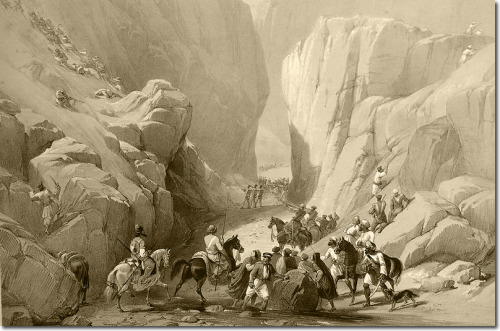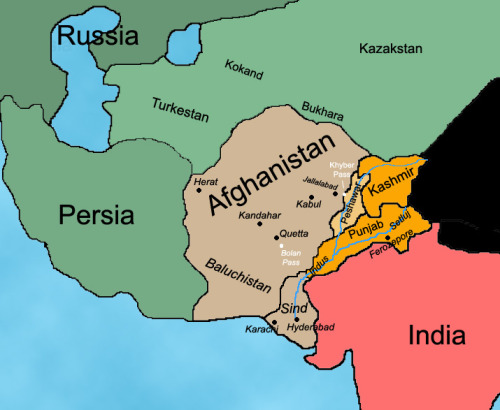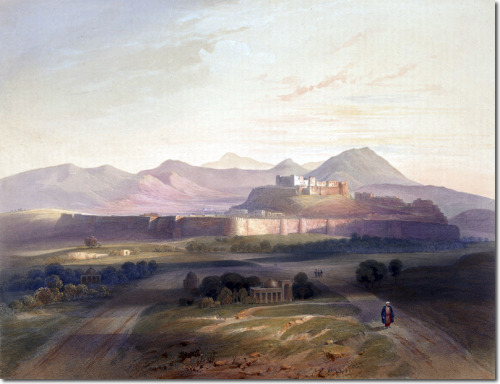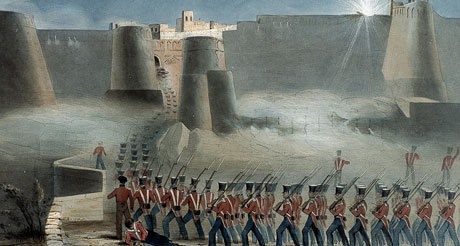peashooter85:The First Anglo Afghan War, Part I —- The Great GameAfghanistan has always been the cro
peashooter85:The First Anglo Afghan War, Part I —- The Great GameAfghanistan has always been the crossroads of mighty empires since Alexander the Great invaded the country in ancient antiquity. Thus, over the centuries mighty empires have sought to control Afghanistan and Central Asia, a quest which in the 19th century was called “The Great Game”. In the late 1830’s, both the borders of the British Empire and Russian Empire were closing in on Afghanistan. After the Crimean War, Russia was not on good terms with the British, and it was feared that the Russians would invade Afghanistan, using it as a stepping stone for a further invasion of British controlled India. The Brits sent an envoy to form and alliance with Afghanistan’s rulle, Dost Mohammed. However Mohammed wanted the British to in turn ally with Afghanistan against the Sikhs, who had conquered the former Afghan territory of Peshawar. This was impossible, since the British had an alliance with the Sikhs. Then the Russians allied with Persia, and laid siege to Afghan territory in the west. It seemed as though Russia was making its move, so in 1839 Britain decided to invade Afghanistan.During the spring of 1839 British forces under the command of Sir John Keene crossed the border into Afghanistan from the southern passes. The 20,500 troops under Keene’s command were not regular British Army, but British East India Company forces. From the time of the first British colonies in India up until the mid 1850’s, the East India Company ruled and administrated the British Dominion of India. The East India Company had its own army and navy, and due to the wealth of the company Company forces were actually better equipped and better trained than most regular military forces. The British East India Army was a collection of Indian soldiers called sepoys, as well as men recruited from Britain, and a number of Afghan allies. While traveling through the rugged mountain terrain of the Bolan Pass in southern Pakistan/Afghanistan, the British Army had to leave most of its heavy equipment, large cannon, and pack animals behind. This was a problem because the main obstacle in between the mountains and Kabul was the city of Kandahar, guarded by the “impregnable” walls of the fortress of Ghazni. The British reached Kandahar on May 4th, 1839, and immediately it was apparent that the fortress of Ghazni would be a formidable challenge. With 70 foot high walls, a flooded moat, large hardwood gates which had been sealed with large rocks, and plenty of food and water for a lengthy siege, it seemed that the fortress would be impenetrable without heavy artillery. Artillery which the British had been forced to leave behind. However, interrogation of captured Afghan soldiers revealed that the north facing gate was left unsealed in order to allow communication and supplies to and from Kabul. On July 22nd, under the cover of light artillery fire Indian engineers blew the gate with explosives. The British immediately stormed the fortress, engaging the Afghans in hand to hand combat. The fighting lasted all day and all night. By morning, British forces had reach the city center and had captured Kandahar. The British claimed losses of 17 dead and 165 wounded. The Afghans lost around 500 men. The fall of Kandahar cleared the way for the final march on the capital of Kabul. Shortly afterward, the government of Dost Mohammed quickly collapsed, and Mohammed was forced flee to what is now modern Uzbekistan. Seven days later British forces marched unopposed in Kabul. There were no victory celebrations or warm greetings offered by the Afghans, just indignant stares and angry glances. To the British, conquering Afghanistan was easy. However, as many great empires throughout history have learned, holding Afghanistan is much more difficult. Little did the British know, but their great victory at Kandahar and Kabul would lead to one of the worst British military disasters of the 19th century. -- source link
Tumblr Blog : peashooter85.tumblr.com



